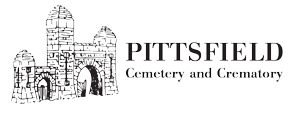Funerals as Unique as Your Life
At times like this, it can be difficult to get the help you need. That’s why we provide services that make it easy for you to concentrate on what is most important to you. Your loved-ones and friends will appreciate the fact that you will have less to worry about during hard times like these and can turn to us for assistance.
Please feel free to contact us directly for any special needs you may have. We’re always here to help.
Property Alterations
From 1850 to 1891 various small parcels of land were added to the original grounds. In 1891 the Merriam Farm on Onota Street was purchased for $17,200. This new area comprised of about 177 acres , extending from Onota Street to Onota Lake. In 1916 the western portion of this tract, about 79 acres , was sold to the City of Pittsfield for $17,145 and to be used as a park. It is now called Burbank Park. The remaining land was surveyed in 1914 by the Olmstead Brothers of Boston and a complete plan was made showing the most practical use of the land for cemetery purposes. In 1897 the land on both sides of Onota Street south of the present cemetery limits was subdivided and sold for building plots. Proceeds from these sales went to thePerpetual Care Endowment Fund.
In 1988 an additional parcel was sold to the City of Pittsfield, after it had been determined that the city built Onota Lake Boulevard on our property not on theirs. After a period of negotiation, the parcel where the road was supposed to go was turned over to the Cemetery in exchange for the already completed Boulevard. Since this 7.5 acre property was of no use to the Cemetery, it was sold to John Wendling for $100,000.
An Onota Expansion on the west side of Onota Street took place over many years and was completed and opened on September 9th 2000. This added about fifteen acres of developed land to the cemetery’s burial inventory. This opening coincided with the cemetery’s 150th anniversary.
Growth of Services:
For the early years of the Cemetery the only services available were digging graves and making internments. With the addition of a Superintendent, the cemetery undertook the care of grass and digging foundations for memorial stones . As time progressed other services were added such as cremation services in 1959, free chapel use became available, planting shrubs and flowers, cleaning memorial stones, etc. Before the advent of modern machines, winter interments were a major problem as some winters produced over three feet of frost in the ground. A receiving Tomb was erected in 1865 at a cost of $2,000 for the temporary storage of remains until the spring thaws enabled earth interments to be made. The Tomb was no longer necessary with the development of machines to break through the frozen ground. In 1959 the Receiving Tomb was converted to the county’s only Crematory and was in continuous use from 1959 until 2002. In November of 2002 a new crematory was put on line after it was determined that the old crematory was going to require numerous major repairs and upgrades.
This new crematory was added onto the Martin Memorial Chapel in order to provide a more complete crematory service. The 1900 chapel which had been unused for fifty years was in need of interior and exterior renovations before it could be utilized once again as a functioning facility. The chapel is now able to offer services for funerals, memorial services, cremation services and weddings. The chapel on one particular occasion was used for a dinner party and magic show for the benefit of the Colonial Theatre.
Up keep and services all have a cost. These costs are covered by lot sales, interments, cremations, foundation , monument and lawn marker preparation, cleaning of monuments, over-capacity charges, vault sales, after hour services , floral decorations where funded by a Trust account and income from our Perpetual Care Fund.
The Perpetual Care Fund was set up in 1895 and was set up to help with the financial needs of the Cemetery. Most lots purchased since 1895 have included an amount in the cost of the lot that will be deposited in this endowment account.
Gifts and Bequests
The entrance gateway on Wahconah Street was erected in 1884 through a bequest provided in the will of the late Thomas Allen. His widow, Ann Russell Allen, gave the bronze gates to complete the entrance way. The structure was designed by J. Phillip Rinn of Boston and was constructed of Great Barrington
Blue Stone.
The Martin Memorial Chapel was dedicated on October 17, 1900 by Mary Martin Clapp, fifty years after the opening of the Pittsfield Cemetery. The chapel is a memorial to Mary’s father, Calvin Martin, who was one of the original incorporators of the cemetery and the first President of the board of directors.
An endowment in the amount of $10,000 was provided by Mary G. Clapp Bagg so that the chapel will be properly maintained and used at no charge required for services held in the building.
The Sloan Memorial Bridge which crosses the brook flowing near the entrance to the grounds was provided by a gift from Dr. Joseph D. Howe in memory of his uncle the late William H. Sloan. The bridge was built in 1932 of reinforced concrete.
The late May Wolfe left a bequest of $5,000 in her will to be used for the general purposes of the cemetery, this money was received in 1944 and added to the Perpetual Care Fund.
The iron picket fence running along part of Wahconah Street, was a gift to the cemetery by the late Charles L. Hibbard, who was the president of the cemetery at the time of his death in 1947.
